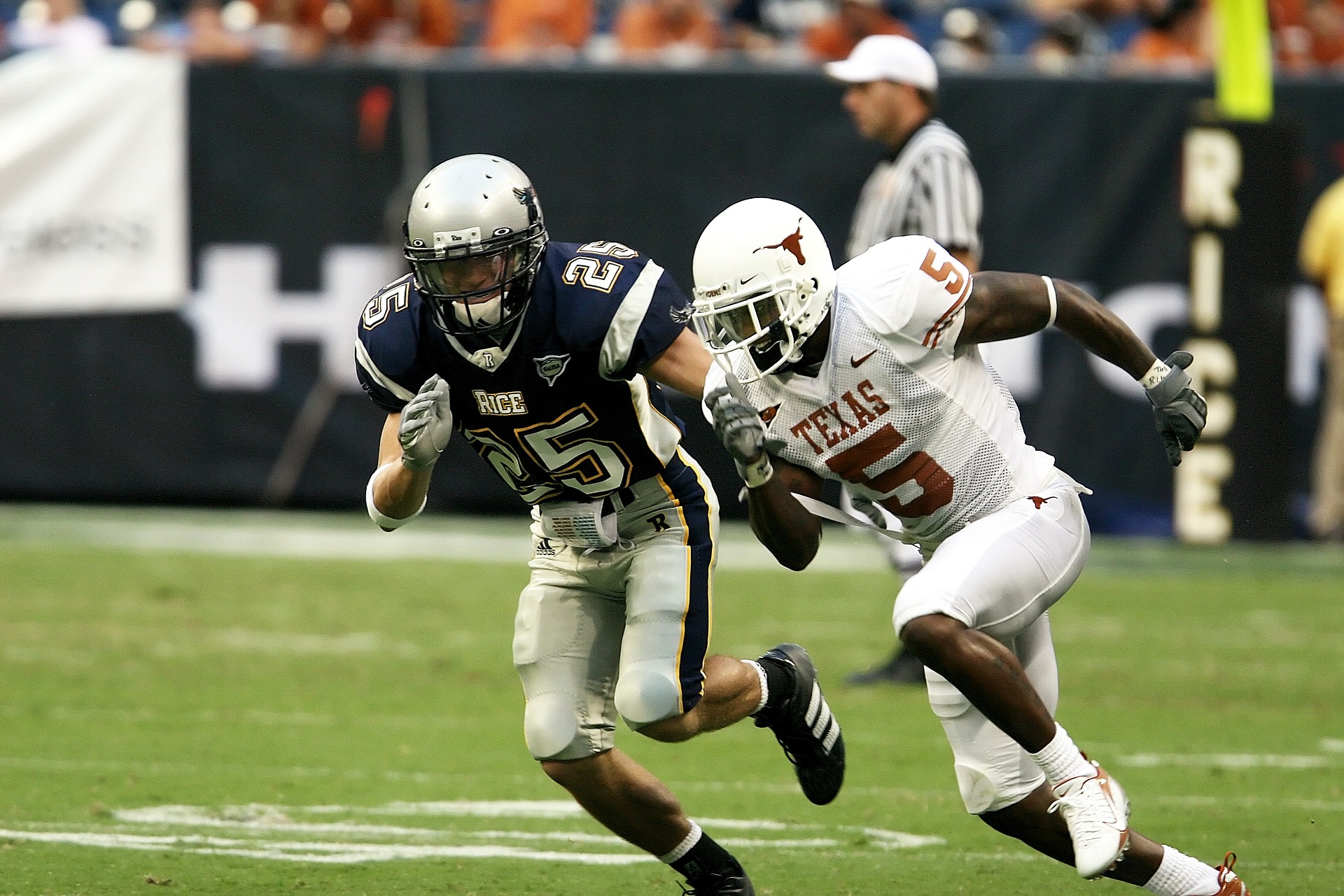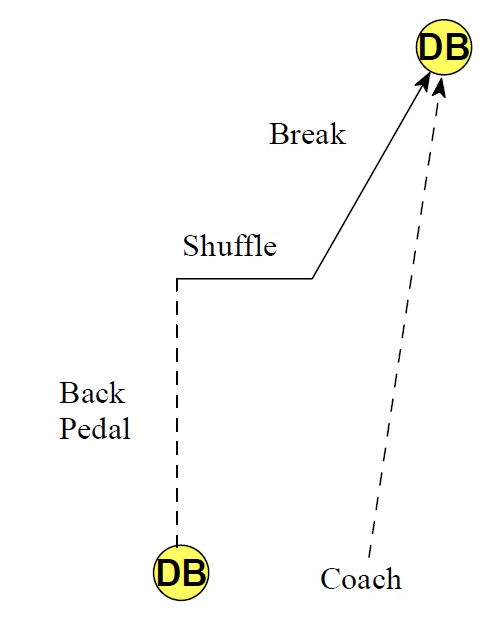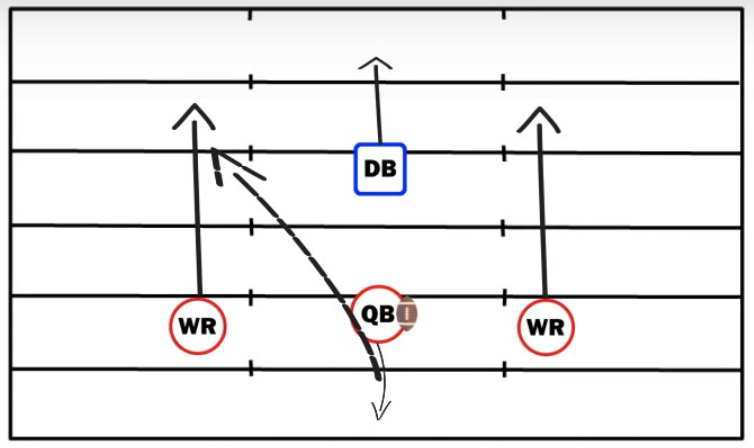Presented on US Sports Net By Game Planner Pro!
Enter Code USSports to save 10% Off the annual subscription Learn more...
Game Planner Pro takes football coaching preparation to a whole new level.
Now this from CoachTube Football!
9 Best Defensive Back Drills
- By Rick Bouch
Purpose: To properly execute the backpedal technique.
Execution: A number of defensive backs can do the drill at once. From a good starting position – knees bent at a 45-degree angle, weight on the balls of the feet, head up, and back straight – a coach will give the command to begin the backpedal. Defensive backs work on pushing off the front foot and continuing the backpedal. Coaches stress keeping the chest over the feet as well as telling players to keep their feet close to the ground. Defensive backs should also use their arms just like they were running forward. The drill can progress from half speed to full speed to help players perfect the backpedal.
Execution: A number of defensive backs can do the drill at once. From a good starting position – knees bent at a 45-degree angle, weight on the balls of the feet, head up, and back straight – a coach will give the command to begin the backpedal. Defensive backs work on pushing off the front foot and continuing the backpedal. Coaches stress keeping the chest over the feet as well as telling players to keep their feet close to the ground. Defensive backs should also use their arms just like they were running forward. The drill can progress from half speed to full speed to help players perfect the backpedal.
Backpedal, Shuffle and Break
Purpose: To help defensive backs progress from the backpedal to running with a receiver.
Execution: On command, a defensive back begins first with the backpedal. On the next command, the player begins a shuffle for two to three steps to get in position for the final phase of the drill. The final command tells the defensive back to turn and run with a receiver. The defender breaks on the ball when the coach throws it. The drill can be done on air or can utilize other DBs as receivers so the defender gets a better idea of turning and running with a receiver.
Purpose: To help defensive backs progress from the backpedal to running with a receiver.
Execution: On command, a defensive back begins first with the backpedal. On the next command, the player begins a shuffle for two to three steps to get in position for the final phase of the drill. The final command tells the defensive back to turn and run with a receiver. The defender breaks on the ball when the coach throws it. The drill can be done on air or can utilize other DBs as receivers so the defender gets a better idea of turning and running with a receiver.
90-Degree Break
Purpose: To teach a defensive back to break and drive for the football.
Execution: On command, a defensive back begins the drill in a backpedal. On the next command, the defender plants a foot in the ground and breaks at 90 degrees (horizontally from the line of scrimmage). If the ball is not thrown, the player will continue in a backpedal. Again on command, the player will execute the 90-degree break but this time in the opposite direction. The drill continues until the coach throws the ball and the defender breaks on it and intercepts it.
Purpose: To teach a defensive back to break and drive for the football.
Execution: On command, a defensive back begins the drill in a backpedal. On the next command, the defender plants a foot in the ground and breaks at 90 degrees (horizontally from the line of scrimmage). If the ball is not thrown, the player will continue in a backpedal. Again on command, the player will execute the 90-degree break but this time in the opposite direction. The drill continues until the coach throws the ball and the defender breaks on it and intercepts it.
Weave Drill
Purpose: To improve agility and to maintain proper positioning on a moving receiver.
Execution: A defensive back lines up inside or outside on a receiver at a distance of five yards. The receiver will come off the line of scrimmage and change direction at least twice. The defender’s job is to maintain his relationship – inside or outside, wherever he started the drill – on the receiver. The defender will weave in order to do so. Coaches must pay attention to the defender’s hips. They should remain square. The defender continues to backpedal but at an angle while maintaining proper relationship with the receiver.
Purpose: To improve agility and to maintain proper positioning on a moving receiver.
Execution: A defensive back lines up inside or outside on a receiver at a distance of five yards. The receiver will come off the line of scrimmage and change direction at least twice. The defender’s job is to maintain his relationship – inside or outside, wherever he started the drill – on the receiver. The defender will weave in order to do so. Coaches must pay attention to the defender’s hips. They should remain square. The defender continues to backpedal but at an angle while maintaining proper relationship with the receiver.
Defend Seam Drill
Purpose: To develop a defensive back’s ball-hawking skills
Execution: A defensive back aligns approximately 15 yards from the line of scrimmage in the middle of the field. Two receivers line up on the hashes with a quarterback in the middle at the line of scrimmage. On command, the quarterback will drop and the receivers will run down the hashes simulating the inside portion of the 4-vertical pass route. The defender backpedals keeping both receivers in front of him while reading the quarterback’s eyes. The passer will turn and throw to one of the receivers. As soon as the quarterback turns, the defender will plant and break on the football. Ideally, the defensive back will intercept the ball and return it at least 10 yards. The defender may also knock the ball away preventing the reception if he cannot make the pick.
Purpose: To develop a defensive back’s ball-hawking skills
Execution: A defensive back aligns approximately 15 yards from the line of scrimmage in the middle of the field. Two receivers line up on the hashes with a quarterback in the middle at the line of scrimmage. On command, the quarterback will drop and the receivers will run down the hashes simulating the inside portion of the 4-vertical pass route. The defender backpedals keeping both receivers in front of him while reading the quarterback’s eyes. The passer will turn and throw to one of the receivers. As soon as the quarterback turns, the defender will plant and break on the football. Ideally, the defensive back will intercept the ball and return it at least 10 yards. The defender may also knock the ball away preventing the reception if he cannot make the pick.
Cushion Drill
Purpose: To help a defender maintain his cushion on a receiver and prevent the receiver from getting behind him.
Execution: A receiver aligns at the line of scrimmage. A defensive back lines up – inside or outside – on the receiver. On command, the receiver takes off and the defender uses his backpedal to maintain his cushion on him. When the receiver comes within three yards of the defensive back, he must turn and run so he does not allow the receiver to get behind him. Coaches should point out that the defensive back wants to intersect roughly half to a third of his body in front of the receiver. By doing so, the defender is not allowing the receiver an easy path to get downfield. Defenders must turn quickly and run to ensure they are not beaten deep.
Purpose: To help a defender maintain his cushion on a receiver and prevent the receiver from getting behind him.
Execution: A receiver aligns at the line of scrimmage. A defensive back lines up – inside or outside – on the receiver. On command, the receiver takes off and the defender uses his backpedal to maintain his cushion on him. When the receiver comes within three yards of the defensive back, he must turn and run so he does not allow the receiver to get behind him. Coaches should point out that the defensive back wants to intersect roughly half to a third of his body in front of the receiver. By doing so, the defender is not allowing the receiver an easy path to get downfield. Defenders must turn quickly and run to ensure they are not beaten deep.
Zone Flip Drill
Purpose: To execute the zone flip technique properly.
Execution: A defensive back aligns approximately six to eight yards off the line of scrimmage and two yards inside of a receiver (who is on the line of scrimmage). On command, the defender will execute the zone flip. His eyes must see everything, meaning he must see the release of the receiver as well as the quarterback. The defensive back’s back will be to the sideline as he “presses” the receiver that direction. The purpose of the zone flip is to give the quarterback a false read. The passer will not know whether the defender is playing loose zone or man-to-man. A coach can incorporate a throw into the drill to allow the defender to get comfortable breaking on the ball.
Purpose: To execute the zone flip technique properly.
Execution: A defensive back aligns approximately six to eight yards off the line of scrimmage and two yards inside of a receiver (who is on the line of scrimmage). On command, the defender will execute the zone flip. His eyes must see everything, meaning he must see the release of the receiver as well as the quarterback. The defensive back’s back will be to the sideline as he “presses” the receiver that direction. The purpose of the zone flip is to give the quarterback a false read. The passer will not know whether the defender is playing loose zone or man-to-man. A coach can incorporate a throw into the drill to allow the defender to get comfortable breaking on the ball.
Trail Drill
Purpose: To learn to play trail man-to-man technique properly.
Execution: To begin the drill, a defensive back will line up in a press position against a wide receiver. The defender will align with inside leverage and force the receiver to take an outside release. When the receiver works his release, the defensive back will transition into his trail technique working to press the receiver into the sideline. Knowing he has safety help, the defensive back can be more flexible with his trail technique. Coaches should ensure that defenders never allow an inside release. The drill can progress to having a passer involved as well as a deep safety providing help.
Purpose: To learn to play trail man-to-man technique properly.
Execution: To begin the drill, a defensive back will line up in a press position against a wide receiver. The defender will align with inside leverage and force the receiver to take an outside release. When the receiver works his release, the defensive back will transition into his trail technique working to press the receiver into the sideline. Knowing he has safety help, the defensive back can be more flexible with his trail technique. Coaches should ensure that defenders never allow an inside release. The drill can progress to having a passer involved as well as a deep safety providing help.
Agility Box
Purpose: To improve agility and the ability to stop and start quickly.
Execute: Using a 10 x 10 box, two defensive backs will align directly in the middle. To begin the drill, defenders will fire their feet. Players will then be given a series of commands that force them to change direction frequently. The coach can have the players backpedal, turn at a 45-degree angle and run, break to the line of scrimmage, or turn and run to a given cone. Coaches should emphasize players’ foot placement. Where the feet go, the player will follow.
Other great Defensive Back drills from NY Giants cornerback Brandon Bing
Former Buccaneers Defensive Back coach Ron Cooper's Secret to Great Man Coverage
Purpose: To improve agility and the ability to stop and start quickly.
Execute: Using a 10 x 10 box, two defensive backs will align directly in the middle. To begin the drill, defenders will fire their feet. Players will then be given a series of commands that force them to change direction frequently. The coach can have the players backpedal, turn at a 45-degree angle and run, break to the line of scrimmage, or turn and run to a given cone. Coaches should emphasize players’ foot placement. Where the feet go, the player will follow.
Other great Defensive Back drills from NY Giants cornerback Brandon Bing
Former Buccaneers Defensive Back coach Ron Cooper's Secret to Great Man Coverage






No comments:
Post a Comment